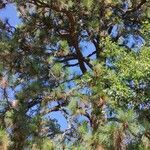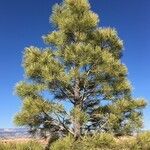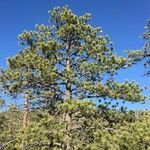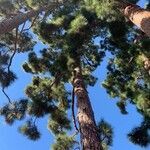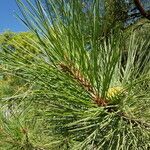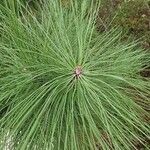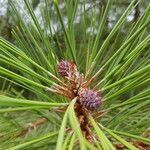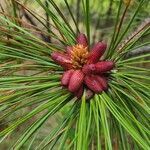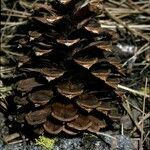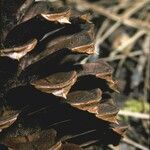Trees to 70 m tall; trunk to 2.5 m d.b.h. in native range; bark yellow-to red-brown, deeply and irregularly furrowed into broadly oblong, scaly plates; crown broadly conical to rounded; branchlets orange-brown, aging darker, stout, rough; winter buds red-brown, ovoid, very resinous, scales white fringed at margin. Needles tufted at apex of branchlets, spreading to erect, (2 or)3(-5) per bundle, deep yellow-green, slightly twisted, 7-25(-30) cm × (1-)1.2-2 mm, pliant, stomatal lines present on all surfaces, base with persistent sheath 1.5-3 cm, margin serrulate. Seed cones solitary or rarely paired, sessile or subsessile, mostly reddish brown, broadly ovoid when open, symmetric or asymmetric, 5-15 cm, maturing in 2 years, then soon shedding seeds, leaving rosettes of scales on branchlets. Apophyses dull or lustrous, thickened, variously raised, cross keeled; umbo usually pyramidal or truncate, rarely depressed or with a reflexed prickle. Seeds brown or yellow-brown, often mottled darker, ellipsoid-obovoid, 3-9 mm; wing 1.5-2.5 cm.
Medium-sized to large, open tree (over 30 m high in cultivation). Bark thick, fissured, reddish brown beneath. Shoots brown or brownish green, glabrous, shining. Buds ovoid or cylindric-ovoid, sometimes large, slightly resinous; scales fimbriate, often dark, free towards apex. Foliage in dense terminal clusters in mature trees, dull green. Lvs 3-(4) per fascicle, 10-23-(27) cm × 1.3-1.6-(2) mm, rigid; resin canals median; sheaths prominent, > 2 cm long when young, 5-20 mm long around older lf bases. ♂ strobili mostly 1.5-2 cm long, broad-cylindric. Conelets sessile; scales aristate. Mature open cones sessile, ± pendent, 6-14-(18) × 5-10 cm, ovoid-oblong before dehiscence, symmetric, shining brown, deciduous and dehiscent at or soon after maturity but leaving basal scales; apophyses flattened or slightly concave; umbo with prickle deflexed at maturity. Seed wing 1.5-2.5 cm long, large, broad, asymmetric.
Tree to 40 m tall. Bark thin, pale greyish brown to yellow, shedding in plates. Resting buds narrowly conical to cylindrical, 10-30 mm long, pale brown, resinous, with closely appressed scales. Leaves glossy, pale green, closely crowded, finely toothed, 13-30 cm long, in bundles of 3, with 3-6 medial resin canals and 2-4 stomatal lines on each surface; basal sheath 10-15 mm long. Female cones ovoid, symmetrical, 7-15 cm long, pedunculate, pendulous, opening and shedding at maturity; scales oblong, with a prominent, acicular, recurved spine. Seeds with a well-developed wing.
A large tree. It can be 70 m tall. The needles are in threes.
